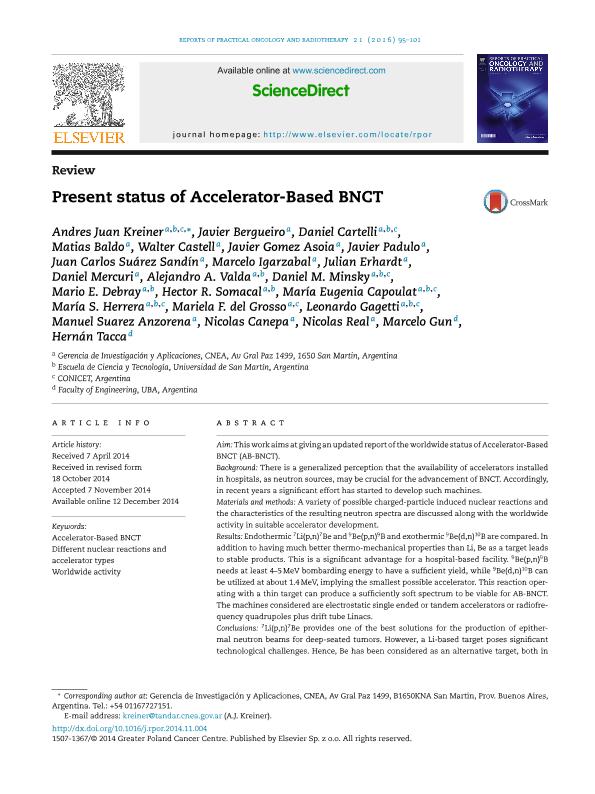Artículo
Present status of Accelerator-Based BNCT
Kreiner, Andres Juan ; Bergueiro, Rodolfo Javier
; Bergueiro, Rodolfo Javier ; Cartelli, Daniel Enrique
; Cartelli, Daniel Enrique ; Baldo, Matias Nicolas
; Baldo, Matias Nicolas ; Castello, Walter Braulio
; Castello, Walter Braulio ; Asoia, Javier Gomez; Padulo, Javier; Suárez Sandín, Juan Carlos; Igarzabal, Marcelo; Erhardt, Julian; Mercuri, Daniel; Valda, Alejandro A.; Minsky, Daniel Mauricio
; Asoia, Javier Gomez; Padulo, Javier; Suárez Sandín, Juan Carlos; Igarzabal, Marcelo; Erhardt, Julian; Mercuri, Daniel; Valda, Alejandro A.; Minsky, Daniel Mauricio ; Debray, Mario Ernesto; Somacal, Héctor Rubén; Capoulat, Maria Eugenia
; Debray, Mario Ernesto; Somacal, Héctor Rubén; Capoulat, Maria Eugenia ; Herrera, Maria Silvia
; Herrera, Maria Silvia ; del Grosso, Mariela Fernanda
; del Grosso, Mariela Fernanda ; Gagetti, Leonardo
; Gagetti, Leonardo ; Suarez Anzorena, Manuel; Canepa, Nicolas; Real, Nicolas; Gun, Marcelo; Tacca, Hernán Emilio
; Suarez Anzorena, Manuel; Canepa, Nicolas; Real, Nicolas; Gun, Marcelo; Tacca, Hernán Emilio
 ; Bergueiro, Rodolfo Javier
; Bergueiro, Rodolfo Javier ; Cartelli, Daniel Enrique
; Cartelli, Daniel Enrique ; Baldo, Matias Nicolas
; Baldo, Matias Nicolas ; Castello, Walter Braulio
; Castello, Walter Braulio ; Asoia, Javier Gomez; Padulo, Javier; Suárez Sandín, Juan Carlos; Igarzabal, Marcelo; Erhardt, Julian; Mercuri, Daniel; Valda, Alejandro A.; Minsky, Daniel Mauricio
; Asoia, Javier Gomez; Padulo, Javier; Suárez Sandín, Juan Carlos; Igarzabal, Marcelo; Erhardt, Julian; Mercuri, Daniel; Valda, Alejandro A.; Minsky, Daniel Mauricio ; Debray, Mario Ernesto; Somacal, Héctor Rubén; Capoulat, Maria Eugenia
; Debray, Mario Ernesto; Somacal, Héctor Rubén; Capoulat, Maria Eugenia ; Herrera, Maria Silvia
; Herrera, Maria Silvia ; del Grosso, Mariela Fernanda
; del Grosso, Mariela Fernanda ; Gagetti, Leonardo
; Gagetti, Leonardo ; Suarez Anzorena, Manuel; Canepa, Nicolas; Real, Nicolas; Gun, Marcelo; Tacca, Hernán Emilio
; Suarez Anzorena, Manuel; Canepa, Nicolas; Real, Nicolas; Gun, Marcelo; Tacca, Hernán Emilio
Fecha de publicación:
03/2016
Editorial:
Elsevier
Revista:
Reports of Practical Oncology and Radiotherapy
ISSN:
1507-1367
Idioma:
Inglés
Tipo de recurso:
Artículo publicado
Clasificación temática:
Resumen
Aim: This work aims at giving an updated report of the worldwide status of Accelerator-Based BNCT (AB-BNCT). Background: There is a generalized perception that the availability of accelerators installed in hospitals, as neutron sources, may be crucial for the advancement of BNCT. Accordingly, in recent years a significant effort has started to develop such machines. Materials and methods: A variety of possible charged-particle induced nuclear reactions and the characteristics of the resulting neutron spectra are discussed along with the worldwide activity in suitable accelerator development. Results: Endothermic 7Li(p,n)7Be and 9Be(p,n)9B and exothermic 9Be(d,n)10B are compared. In addition to having much better thermo-mechanical properties than Li, Be as a target leads to stable products. This is a significant advantage for a hospital-based facility. 9Be(p,n)9B needs at least 4-5 MeV bombarding energy to have a sufficient yield, while 9Be(d,n)10B can be utilized at about 1.4 MeV, implying the smallest possible accelerator. This reaction operating with a thin target can produce a sufficiently soft spectrum to be viable for AB-BNCT. The machines considered are electrostatic single ended or tandem accelerators or radiofrequency quadrupoles plus drift tube Linacs. Conclusions: 7Li(p,n)7Be provides one of the best solutions for the production of epithermal neutron beams for deep-seated tumors. However, a Li-based target poses significant technological challenges. Hence, Be has been considered as an alternative target, both in combination with (p,n) and (d,n) reactions. 9Be(d,n)10B at 1.4 MeV, with a thin target has been shown to be a realistic option for the treatment of deep-seated lesions.
Archivos asociados
Licencia
Identificadores
Colecciones
Articulos(SEDE CENTRAL)
Articulos de SEDE CENTRAL
Articulos de SEDE CENTRAL
Citación
Kreiner, Andres Juan; Bergueiro, Rodolfo Javier; Cartelli, Daniel Enrique; Baldo, Matias Nicolas; Castello, Walter Braulio; et al.; Present status of Accelerator-Based BNCT; Elsevier; Reports of Practical Oncology and Radiotherapy; 21; 2; 3-2016; 95-101
Compartir
Altmétricas



